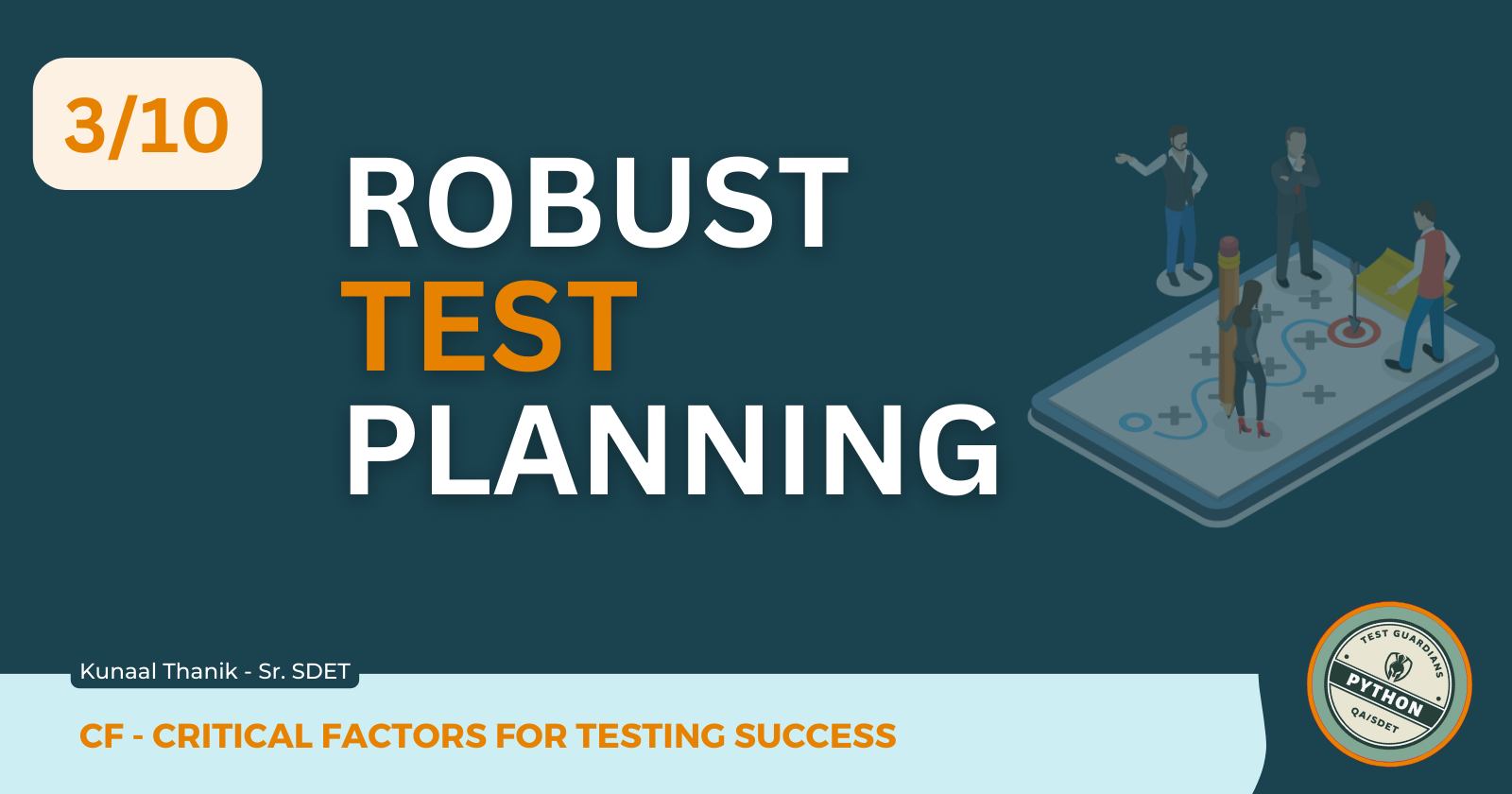CF3 - Robust Test Planning
 Kunaal Thanik
Kunaal Thanik
Creating a test plan might sound like serious business, but it doesn't have to be boring! Let's dive into the key concepts with a splash of fun, featuring the latest tools and real-world facts.
1. Define Objectives and Scope: The Blueprint
Defining objectives and scope is the foundational step in any testing project, serving as a roadmap for the entire process. This crucial phase involves two key components:
Project Goals: Clearly outline what you want to achieve with your testing efforts.
Clearly articulate the desired outcomes of your testing efforts. These goals should be specific, measurable, achievable, relevant, and time-bound (SMART). Examples might include improving user experience, ensuring system stability, or validating new features.
Test Scope: Identify which features, functionalities, and components will be tested. Now, the test scope is like your route and itinerary. You decide which highways to take (features to test) and which attractions to see along the way (specific functionalities). But remember, you can't stop at every roadside diner or quirky museum - that's deciding what not to test.
Cool Tools**:**
Jira: Great for managing project goals and test scopes.
TestRail: Helps in tracking test cases and requirements.
2. Requirement Analysis: The Detective Work
Imagine you're a detective piecing together a puzzle. That's what requirement analysis is all about in software testing. It's like gathering clues to understand the full picture of what your application needs to do.
Functional Requirements: Understand what your application should do.
Functional requirements are the "who, what, when, where" of your app - the core features it should perform. Think of these as the main characters in your story.
Non-Functional Requirements: Pin down performance, usability, security, and other criteria. Non-functional requirements are the "how well" - like performance, usability, and security. These are the setting and atmosphere that make your story come alive.
By thoroughly investigating both, you ensure your testing covers all bases, creating a robust and user-friendly application.
Smart Tools:
Confluence: Perfect for documenting functional and non-functional requirements.
QTest: Integrates seamlessly for detailed requirement analysis.
3. Test Strategy: The Game Plan
Think of your software project as a grand orchestra. Your test strategy is akin to the conductor’s sheet music, orchestrating every note and instrument with precision.
Testing Types: Decide on the types of testing (e.g., unit, integration, system, acceptance). Different Testing Types are like the various sections of an orchestra: strings, brass, woodwinds, and percussion. Each type, whether it’s unit, integration, system, or acceptance testing, contributes uniquely, just like violins and trumpets add their own distinct sounds. Your challenge is to select the right mix of these sections to achieve a harmonious result.
Testing Levels: Outline levels of testing, from individual components to full system tests. Testing Levels can be compared to a series of rehearsals. It begins with solo practices (component testing), then moves to ensemble rehearsals (integration testing), followed by section rehearsals (system testing), and culminates in the full orchestra’s dress rehearsal (acceptance testing). Each level builds on the previous one, ensuring a seamless performance when the final show arrives.
Top Picks:
Selenium: Popular for web testing.
Postman: Essential for API testing.
Appium: The go-to for mobile testing.
4. Resource Allocation: The Team Play
Imagine your testing project as a grand sports event, where your team is the MVP and the key to success!
Human Resources: Assign roles and responsibilities to your team members. Envision your team as a group of superheroes, each with their own unique abilities. Assign roles as if you're assembling the ultimate dream team. Who is the speedster for rapid tests? Who is the strategist for tackling complex scenarios? By clearly defining each member's role, you ensure everyone knows their contribution to winning the testing championship.
Tools and Infrastructure: Choose the necessary tools and set up your testing environment. Consider your testing environment as the perfect stadium. You need the right equipment to perform at your best. Select tools that match your team's strengths, like choosing the ideal bat or ball. Set up your testing field to replicate real-world conditions. With the right tools and a well-prepared arena, your team is set to achieve testing triumphs!
Hot Tools:
Azure DevOps: Manages your team and resources effectively.
Docker: Great for setting up consistent testing environments.
5. Test Environment Setup: The Perfect Stage
Think of test environment setup as creating the perfect stage for a play. Just like actors need the right props and scenery, software needs the right environment to perform optimally.
Environment Configuration: Make sure your test environment mirrors the production environment. Environment Configuration is setting the stage, mirroring the real-world production environment to ensure authentic performance, just as actors rehearse on a true-to-life set.
Data Preparation: Use data that reflects real-world scenarios. Data Preparation is choosing the right script and props. Realistic data is crucial, much like realistic dialogue and props in a play. This helps uncover potential issues, ensuring your software is ready for its big debut.
Awesome Tools:
AWS: For flexible and scalable test environments.
Mockaroo: Generates realistic test data quickly.
6. Test Case Design: The Creative Process
The Art of Crafting Quality Tests
Test Scenarios: Develop high-level scenarios that cover your application's functionality. Essential in any testing strategy, Test Scenarios serve as overarching stories depicting how users engage with your application. They encompass both typical user interactions and boundary cases, ensuring thorough coverage of critical functions.
Detailed Test Cases: Write steps, expected results, and actual results. These detailed blueprints dissect scenarios into precise steps. Each test case defines inputs, expected outcomes, and actual results, enabling methodical validation of every application facet. This meticulous approach guarantees comprehensive quality assessment.
Test Data: Identify the data required for each test case. Vital for test execution, Test Data includes user inputs, system setups, and environmental variables. Thoughtfully curated, it enhances test realism and uncovers potential issues across diverse scenarios, bolstering overall testing efficacy.
Cool Tools:
TestLink: For creating and managing test cases.
Katalon Studio: Simplifies test case design with a user-friendly interface.
7. Risk Management: Safeguarding Projects
Risk Identification: Spot potential risks that could impact testing. Think of this like planning a road trip. Before hitting the road, you anticipate potential issues such as traffic jams, detours, or bad weather. Similarly, the testing team identifies obstacles like resource shortages, technical glitches, and tight deadlines. This foresight enables them to prepare for different scenarios, ensuring smoother testing phases and project continuity.
Mitigation Plans: Develop strategies to address these risks. Once risks are identified, the team develops contingency plans akin to carrying a spare tire. These plans outline specific actions to address challenges swiftly, minimizing disruptions to the testing process and project schedule. Just as a spare tire ensures you can handle unexpected road bumps, mitigation strategies maintain momentum and project stability.
Best Tools:
RiskWatch: Identifies and manages potential risks.
Xray: Helps integrate risk management with your test plan.
8. Test Schedule: The Timeline
Timeline: Create a detailed timeline for all testing activities. Crafting a detailed timeline is like planning a road trip. Just as you map out each stop and the time to reach it, a testing timeline outlines phases from planning to reporting. Dates for test case creation, execution, bug fixes, and reviews are crucial. This structured approach aligns teams, preempting bottlenecks.
Milestones: Set key milestones and deadlines for various testing phases. Establishing checkpoints, like finishing test case creation or major cycles, guides progress. They motivate and track achievements, ensuring projects stay on track with room for adjustments.
Handy Tools:
Microsoft Project: Ideal for creating detailed schedules.
Smartsheet: Offers a flexible approach to timeline management.
9. Communication Plan: The Update Cycle
Stakeholder Updates: Schedule regular updates to keep everyone in the loop. Set a reliable schedule to keep everyone updated on testing progress. Imagine updating your family weekly about upcoming events, ensuring everyone stays informed and involved.
Reporting Mechanisms: Define how test results and issues will be communicated. Clearly outline how test results and issues will be shared, like using a family calendar or a noticeboard at home. This ensures everyone gets important updates quickly, helping solve any problems that come up.
Communication Tools:
Slack: For real-time updates and collaboration.
Zoom: Perfect for regular check-ins and stakeholder meetings.
10. Metrics and KPIs: The Scoreboard
Test Coverage: Measure how much of your application is tested. Think of test coverage like checking all rooms in your house before leaving. It shows how much of your app gets tested, from code to features. By measuring this, teams know where to test more for a thorough check.
Defect Density: Track the number of defects per unit of software. Defect density counts defects per bit of code, like finding chips in a bag of cookies. It tells how clean your code is and if testing catches enough bugs. A high density might mean coding needs fixing or more testing.
Test Execution Rate: Monitor how fast test cases are executed and passed. This tracks how fast tests run and pass, like timing a race. It checks how well testing works. A high rate means smooth testing, but a low one might need better ways to run tests.
Insightful Tools:
Allure Report: Provides comprehensive test reports.
SonarQube: Great for tracking code quality and defect density.
11. Review and Approval: The Final Check
Peer Reviews: Have team members review test plans, cases, and scripts. Before finalizing testing plans, cases, and scripts, conduct peer reviews. Team members carefully examine each detail, catching potential mistakes and ensuring consistency. This teamwork improves overall testing quality, benefiting from different viewpoints and skills. For example, it's like proofreading a group project before submitting it, making sure everyone's work fits together perfectly.
Stakeholder Approval: Get sign-offs to ensure alignment with project goals. Gain formal approval from key stakeholders on testing documents. This step confirms that our strategy meets project goals and organizational standards. It's a commitment from all parties, ensuring everyone understands and agrees on the testing's purpose and scope. Like getting everyone's agreement on a plan before starting a big group project, it ensures everyone is on the same page and supports the project's success.
Review Tools:
GitHub: For collaborative reviews.
Bitbucket: Helps streamline the approval process.
Fun Fact:
- 88% of QA teams consider robust reporting capabilities essential, and tools like Allure Report are making that easier than ever!
By focusing on these essential concepts and leveraging the latest tools, you can craft a rock-solid test plan that's not only thorough and effective but also a lot of fun to create. Happy testing!
Subscribe to my newsletter
Read articles from Kunaal Thanik directly inside your inbox. Subscribe to the newsletter, and don't miss out.
Written by
